Health Promotion Competencies: Evaluation of Health Promotion Programs
VerifiedAdded on 2020/04/01
|9
|2155
|289
Report
AI Summary
This report provides a comprehensive analysis of health promotion program evaluation, emphasizing its critical role in improving public health outcomes. It begins by defining health promotion programs and the significance of evaluation, highlighting the importance of collecting data to enhance effectiveness and accountability to stakeholders. The report then delves into the three main types of evaluation: process, impact, and outcome. Process evaluation focuses on the implementation of the program, impact evaluation assesses changes attributed to the intervention, and outcome evaluation measures the program's effectiveness in producing change. The report uses real-world examples to illustrate the application of each evaluation type, including a case study of stroke prevention in minority communities. Finally, it emphasizes the importance of conducting all three types of evaluation to ensure the success and sustainability of health promotion programs, with a conclusion that stresses the importance of each type in a community-based health promotion program.
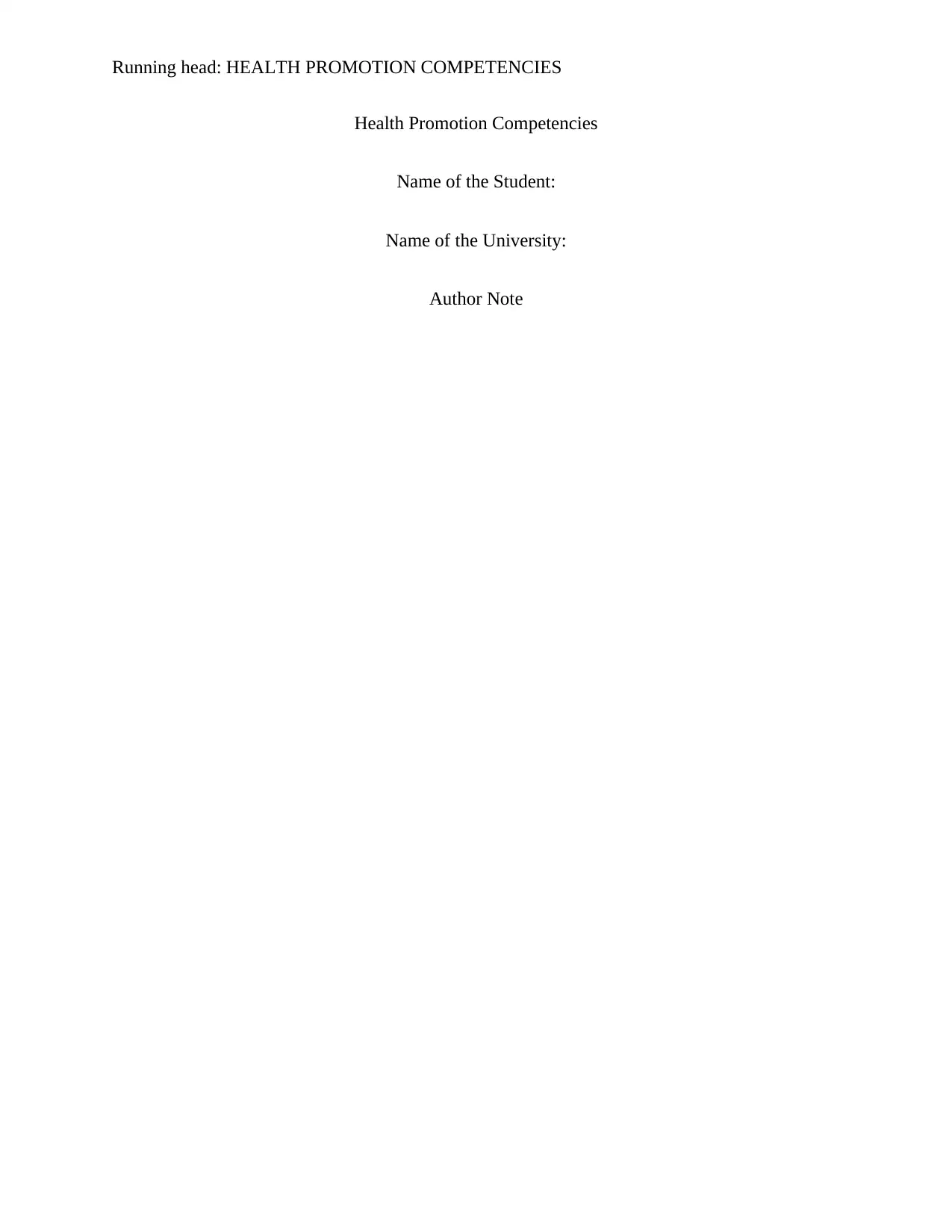
Running head: HEALTH PROMOTION COMPETENCIES
Health Promotion Competencies
Name of the Student:
Name of the University:
Author Note
Health Promotion Competencies
Name of the Student:
Name of the University:
Author Note
Paraphrase This Document
Need a fresh take? Get an instant paraphrase of this document with our AI Paraphraser

1HEALTH PROMOTION COMPETENCIES
The essay here discusses about the importance of evaluation of heath promotion
programs. There is further discussion of the three types of evaluation and their process, impact
and outcomes. The essay also describes how each of the evaluation process holds an importance
in the health promotion programs. There is also an intervention of health promotion in a
community setting with a focus on the aim and objectives of the program and a description of the
process, impact and outcome of the evaluation in reflecting those aims and objectives.
Program referred as group of complementary and related activities intended for achieving
specific results or outcomes. For instance, shopping skill classes, demonstrations for healthy
cooking and community gardens can be program components developed for the improvement of
nutritional status of families with low income (Eldredge et.al 2016). However, evaluation of
program described as the systematic reporting, analysis and gathering of data regarding a
program for assistance in decision-making. Through the process of evaluation, one can also get
access to information that is required for improving the effectiveness of efforts for health
promotion.
The practitioners for health promotion undertake evaluation of health promotion
programs for collection of evidence on the impact or effectiveness of the program. They also
undertake evaluation of health programs in order to be accountable to the stakeholders and to
clients, funders, staff, community and volunteers (Bauman and Nutbeam 2013). The evaluation
of the health promotion program is also important for identifying ways for improving the
program. Evaluation also helps the health practitioners in understanding ways that work and the
reason for which some ways that does not work. The assessment of needs for the target
population understood through the process of evaluation. The process of evaluation of health
promotion programs also helps in the improving of the use of the program materials and for
The essay here discusses about the importance of evaluation of heath promotion
programs. There is further discussion of the three types of evaluation and their process, impact
and outcomes. The essay also describes how each of the evaluation process holds an importance
in the health promotion programs. There is also an intervention of health promotion in a
community setting with a focus on the aim and objectives of the program and a description of the
process, impact and outcome of the evaluation in reflecting those aims and objectives.
Program referred as group of complementary and related activities intended for achieving
specific results or outcomes. For instance, shopping skill classes, demonstrations for healthy
cooking and community gardens can be program components developed for the improvement of
nutritional status of families with low income (Eldredge et.al 2016). However, evaluation of
program described as the systematic reporting, analysis and gathering of data regarding a
program for assistance in decision-making. Through the process of evaluation, one can also get
access to information that is required for improving the effectiveness of efforts for health
promotion.
The practitioners for health promotion undertake evaluation of health promotion
programs for collection of evidence on the impact or effectiveness of the program. They also
undertake evaluation of health programs in order to be accountable to the stakeholders and to
clients, funders, staff, community and volunteers (Bauman and Nutbeam 2013). The evaluation
of the health promotion program is also important for identifying ways for improving the
program. Evaluation also helps the health practitioners in understanding ways that work and the
reason for which some ways that does not work. The assessment of needs for the target
population understood through the process of evaluation. The process of evaluation of health
promotion programs also helps in the improving of the use of the program materials and for
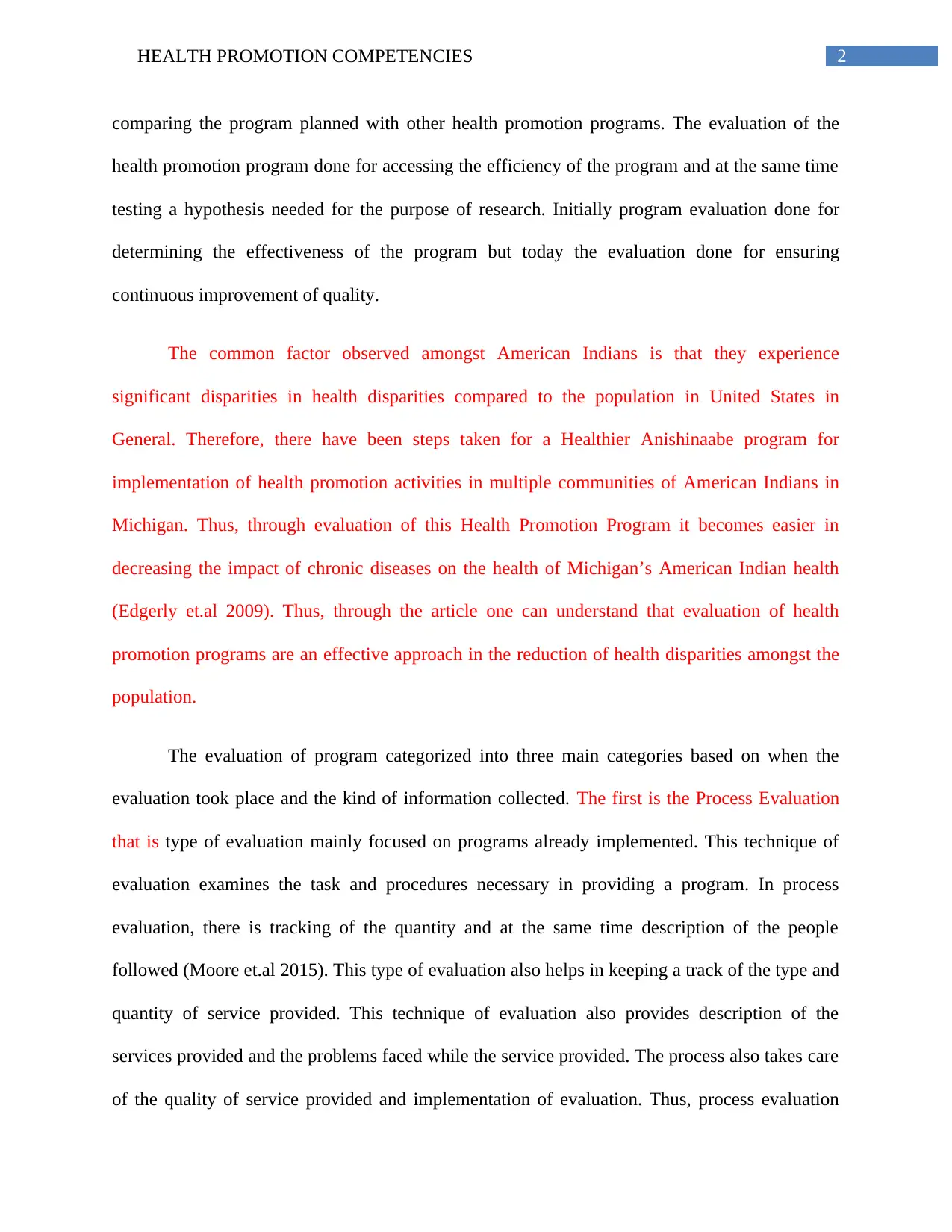
2HEALTH PROMOTION COMPETENCIES
comparing the program planned with other health promotion programs. The evaluation of the
health promotion program done for accessing the efficiency of the program and at the same time
testing a hypothesis needed for the purpose of research. Initially program evaluation done for
determining the effectiveness of the program but today the evaluation done for ensuring
continuous improvement of quality.
The common factor observed amongst American Indians is that they experience
significant disparities in health disparities compared to the population in United States in
General. Therefore, there have been steps taken for a Healthier Anishinaabe program for
implementation of health promotion activities in multiple communities of American Indians in
Michigan. Thus, through evaluation of this Health Promotion Program it becomes easier in
decreasing the impact of chronic diseases on the health of Michigan’s American Indian health
(Edgerly et.al 2009). Thus, through the article one can understand that evaluation of health
promotion programs are an effective approach in the reduction of health disparities amongst the
population.
The evaluation of program categorized into three main categories based on when the
evaluation took place and the kind of information collected. The first is the Process Evaluation
that is type of evaluation mainly focused on programs already implemented. This technique of
evaluation examines the task and procedures necessary in providing a program. In process
evaluation, there is tracking of the quantity and at the same time description of the people
followed (Moore et.al 2015). This type of evaluation also helps in keeping a track of the type and
quantity of service provided. This technique of evaluation also provides description of the
services provided and the problems faced while the service provided. The process also takes care
of the quality of service provided and implementation of evaluation. Thus, process evaluation
comparing the program planned with other health promotion programs. The evaluation of the
health promotion program done for accessing the efficiency of the program and at the same time
testing a hypothesis needed for the purpose of research. Initially program evaluation done for
determining the effectiveness of the program but today the evaluation done for ensuring
continuous improvement of quality.
The common factor observed amongst American Indians is that they experience
significant disparities in health disparities compared to the population in United States in
General. Therefore, there have been steps taken for a Healthier Anishinaabe program for
implementation of health promotion activities in multiple communities of American Indians in
Michigan. Thus, through evaluation of this Health Promotion Program it becomes easier in
decreasing the impact of chronic diseases on the health of Michigan’s American Indian health
(Edgerly et.al 2009). Thus, through the article one can understand that evaluation of health
promotion programs are an effective approach in the reduction of health disparities amongst the
population.
The evaluation of program categorized into three main categories based on when the
evaluation took place and the kind of information collected. The first is the Process Evaluation
that is type of evaluation mainly focused on programs already implemented. This technique of
evaluation examines the task and procedures necessary in providing a program. In process
evaluation, there is tracking of the quantity and at the same time description of the people
followed (Moore et.al 2015). This type of evaluation also helps in keeping a track of the type and
quantity of service provided. This technique of evaluation also provides description of the
services provided and the problems faced while the service provided. The process also takes care
of the quality of service provided and implementation of evaluation. Thus, process evaluation
⊘ This is a preview!⊘
Do you want full access?
Subscribe today to unlock all pages.

Trusted by 1+ million students worldwide
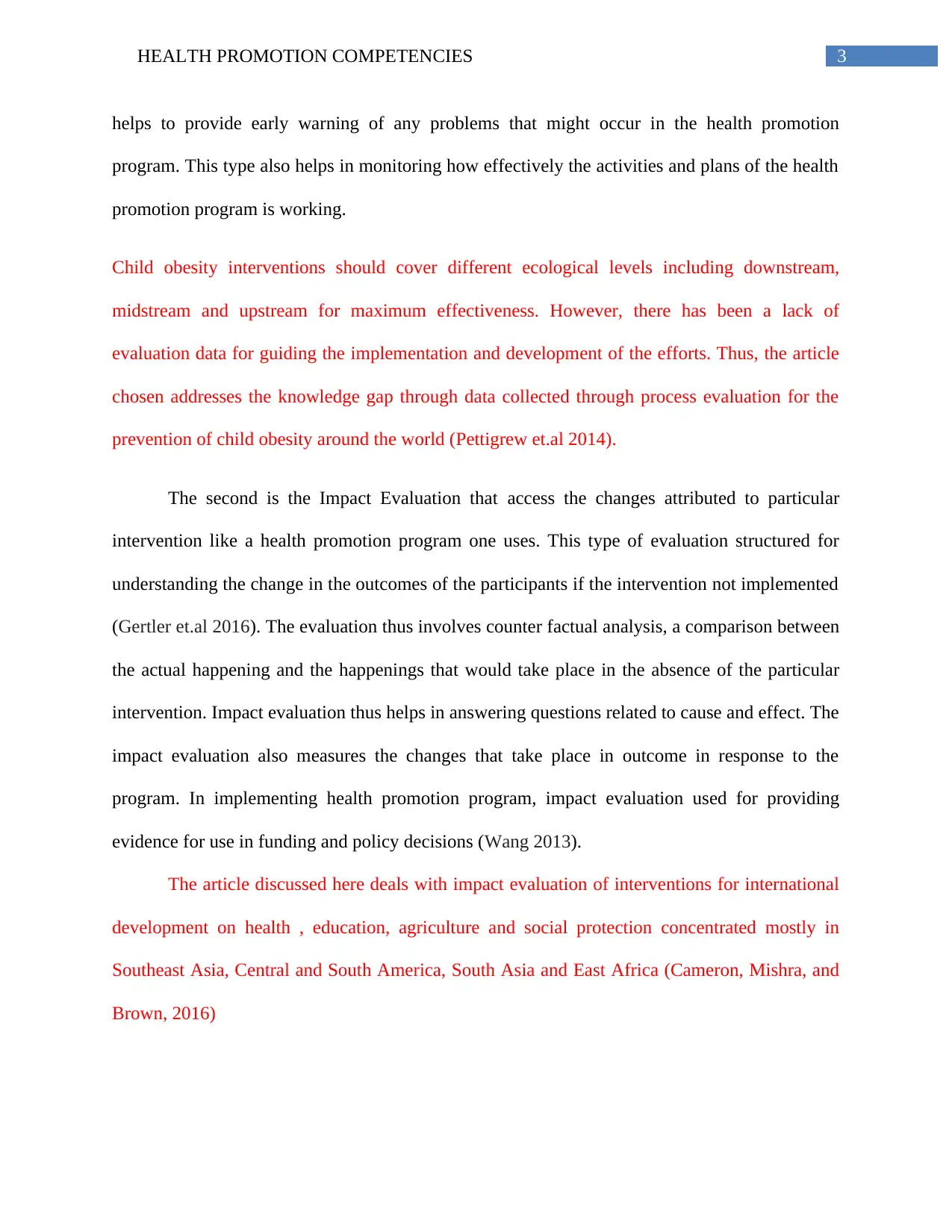
3HEALTH PROMOTION COMPETENCIES
helps to provide early warning of any problems that might occur in the health promotion
program. This type also helps in monitoring how effectively the activities and plans of the health
promotion program is working.
Child obesity interventions should cover different ecological levels including downstream,
midstream and upstream for maximum effectiveness. However, there has been a lack of
evaluation data for guiding the implementation and development of the efforts. Thus, the article
chosen addresses the knowledge gap through data collected through process evaluation for the
prevention of child obesity around the world (Pettigrew et.al 2014).
The second is the Impact Evaluation that access the changes attributed to particular
intervention like a health promotion program one uses. This type of evaluation structured for
understanding the change in the outcomes of the participants if the intervention not implemented
(Gertler et.al 2016). The evaluation thus involves counter factual analysis, a comparison between
the actual happening and the happenings that would take place in the absence of the particular
intervention. Impact evaluation thus helps in answering questions related to cause and effect. The
impact evaluation also measures the changes that take place in outcome in response to the
program. In implementing health promotion program, impact evaluation used for providing
evidence for use in funding and policy decisions (Wang 2013).
The article discussed here deals with impact evaluation of interventions for international
development on health , education, agriculture and social protection concentrated mostly in
Southeast Asia, Central and South America, South Asia and East Africa (Cameron, Mishra, and
Brown, 2016)
helps to provide early warning of any problems that might occur in the health promotion
program. This type also helps in monitoring how effectively the activities and plans of the health
promotion program is working.
Child obesity interventions should cover different ecological levels including downstream,
midstream and upstream for maximum effectiveness. However, there has been a lack of
evaluation data for guiding the implementation and development of the efforts. Thus, the article
chosen addresses the knowledge gap through data collected through process evaluation for the
prevention of child obesity around the world (Pettigrew et.al 2014).
The second is the Impact Evaluation that access the changes attributed to particular
intervention like a health promotion program one uses. This type of evaluation structured for
understanding the change in the outcomes of the participants if the intervention not implemented
(Gertler et.al 2016). The evaluation thus involves counter factual analysis, a comparison between
the actual happening and the happenings that would take place in the absence of the particular
intervention. Impact evaluation thus helps in answering questions related to cause and effect. The
impact evaluation also measures the changes that take place in outcome in response to the
program. In implementing health promotion program, impact evaluation used for providing
evidence for use in funding and policy decisions (Wang 2013).
The article discussed here deals with impact evaluation of interventions for international
development on health , education, agriculture and social protection concentrated mostly in
Southeast Asia, Central and South America, South Asia and East Africa (Cameron, Mishra, and
Brown, 2016)
Paraphrase This Document
Need a fresh take? Get an instant paraphrase of this document with our AI Paraphraser
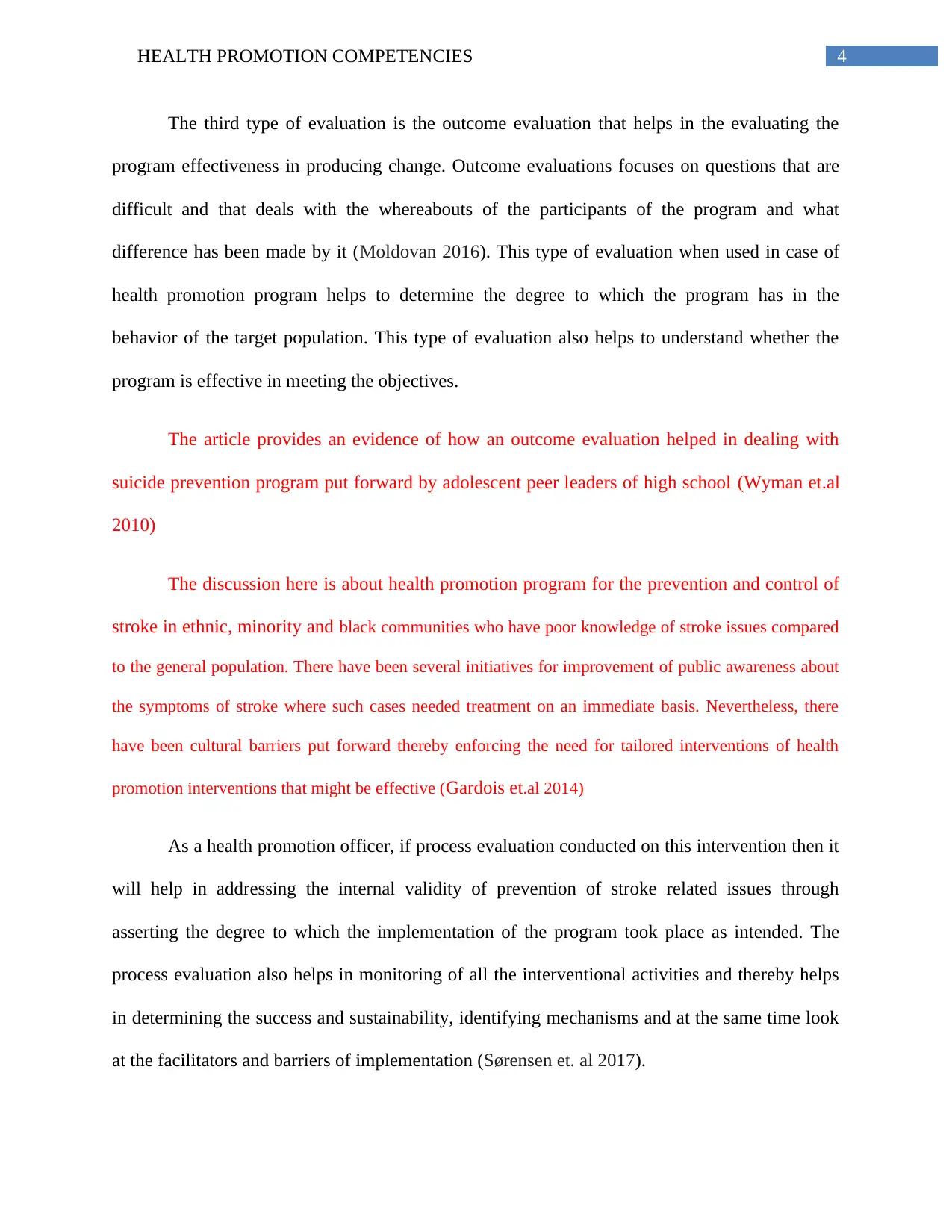
4HEALTH PROMOTION COMPETENCIES
The third type of evaluation is the outcome evaluation that helps in the evaluating the
program effectiveness in producing change. Outcome evaluations focuses on questions that are
difficult and that deals with the whereabouts of the participants of the program and what
difference has been made by it (Moldovan 2016). This type of evaluation when used in case of
health promotion program helps to determine the degree to which the program has in the
behavior of the target population. This type of evaluation also helps to understand whether the
program is effective in meeting the objectives.
The article provides an evidence of how an outcome evaluation helped in dealing with
suicide prevention program put forward by adolescent peer leaders of high school (Wyman et.al
2010)
The discussion here is about health promotion program for the prevention and control of
stroke in ethnic, minority and black communities who have poor knowledge of stroke issues compared
to the general population. There have been several initiatives for improvement of public awareness about
the symptoms of stroke where such cases needed treatment on an immediate basis. Nevertheless, there
have been cultural barriers put forward thereby enforcing the need for tailored interventions of health
promotion interventions that might be effective (Gardois et.al 2014)
As a health promotion officer, if process evaluation conducted on this intervention then it
will help in addressing the internal validity of prevention of stroke related issues through
asserting the degree to which the implementation of the program took place as intended. The
process evaluation also helps in monitoring of all the interventional activities and thereby helps
in determining the success and sustainability, identifying mechanisms and at the same time look
at the facilitators and barriers of implementation (Sørensen et. al 2017).
The third type of evaluation is the outcome evaluation that helps in the evaluating the
program effectiveness in producing change. Outcome evaluations focuses on questions that are
difficult and that deals with the whereabouts of the participants of the program and what
difference has been made by it (Moldovan 2016). This type of evaluation when used in case of
health promotion program helps to determine the degree to which the program has in the
behavior of the target population. This type of evaluation also helps to understand whether the
program is effective in meeting the objectives.
The article provides an evidence of how an outcome evaluation helped in dealing with
suicide prevention program put forward by adolescent peer leaders of high school (Wyman et.al
2010)
The discussion here is about health promotion program for the prevention and control of
stroke in ethnic, minority and black communities who have poor knowledge of stroke issues compared
to the general population. There have been several initiatives for improvement of public awareness about
the symptoms of stroke where such cases needed treatment on an immediate basis. Nevertheless, there
have been cultural barriers put forward thereby enforcing the need for tailored interventions of health
promotion interventions that might be effective (Gardois et.al 2014)
As a health promotion officer, if process evaluation conducted on this intervention then it
will help in addressing the internal validity of prevention of stroke related issues through
asserting the degree to which the implementation of the program took place as intended. The
process evaluation also helps in monitoring of all the interventional activities and thereby helps
in determining the success and sustainability, identifying mechanisms and at the same time look
at the facilitators and barriers of implementation (Sørensen et. al 2017).
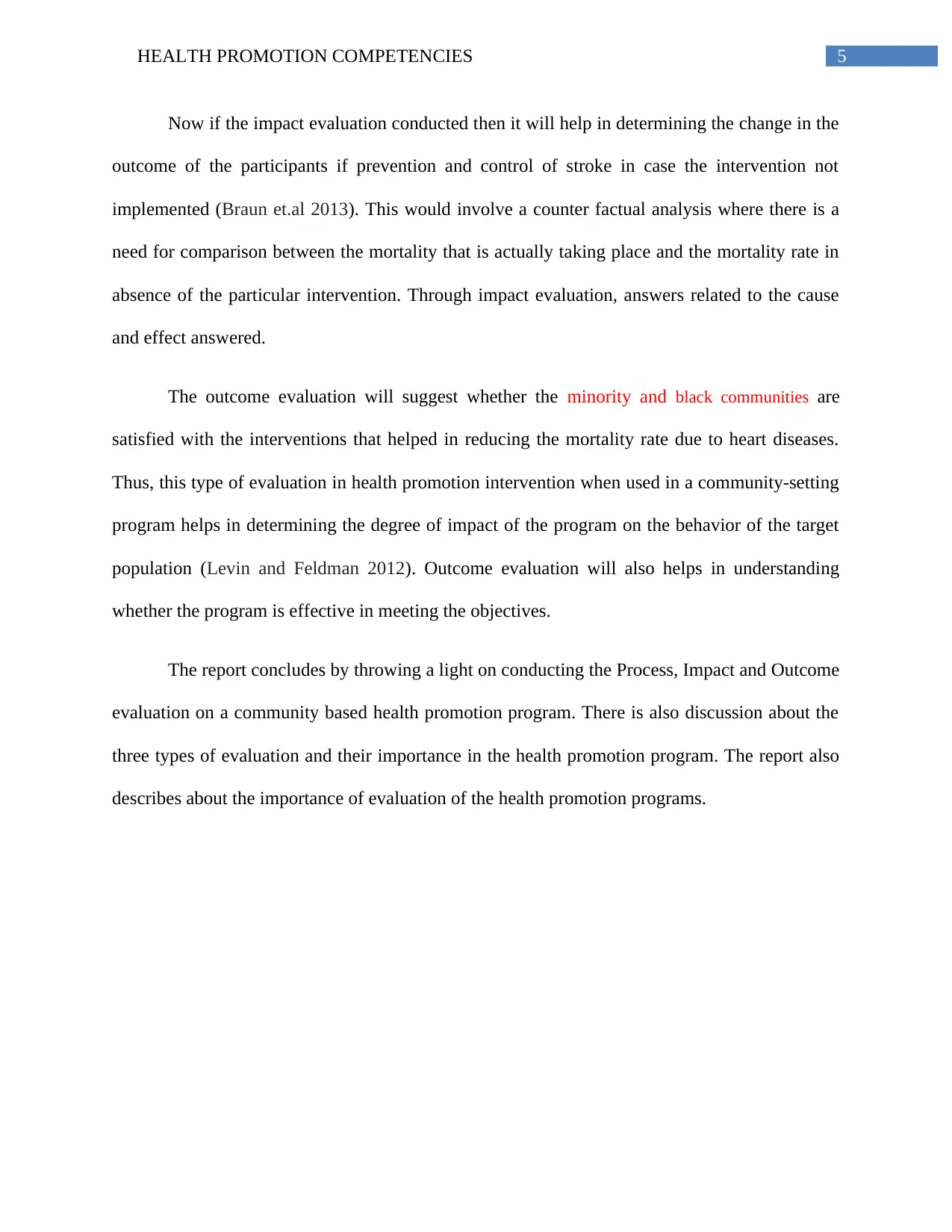
5HEALTH PROMOTION COMPETENCIES
Now if the impact evaluation conducted then it will help in determining the change in the
outcome of the participants if prevention and control of stroke in case the intervention not
implemented (Braun et.al 2013). This would involve a counter factual analysis where there is a
need for comparison between the mortality that is actually taking place and the mortality rate in
absence of the particular intervention. Through impact evaluation, answers related to the cause
and effect answered.
The outcome evaluation will suggest whether the minority and black communities are
satisfied with the interventions that helped in reducing the mortality rate due to heart diseases.
Thus, this type of evaluation in health promotion intervention when used in a community-setting
program helps in determining the degree of impact of the program on the behavior of the target
population (Levin and Feldman 2012). Outcome evaluation will also helps in understanding
whether the program is effective in meeting the objectives.
The report concludes by throwing a light on conducting the Process, Impact and Outcome
evaluation on a community based health promotion program. There is also discussion about the
three types of evaluation and their importance in the health promotion program. The report also
describes about the importance of evaluation of the health promotion programs.
Now if the impact evaluation conducted then it will help in determining the change in the
outcome of the participants if prevention and control of stroke in case the intervention not
implemented (Braun et.al 2013). This would involve a counter factual analysis where there is a
need for comparison between the mortality that is actually taking place and the mortality rate in
absence of the particular intervention. Through impact evaluation, answers related to the cause
and effect answered.
The outcome evaluation will suggest whether the minority and black communities are
satisfied with the interventions that helped in reducing the mortality rate due to heart diseases.
Thus, this type of evaluation in health promotion intervention when used in a community-setting
program helps in determining the degree of impact of the program on the behavior of the target
population (Levin and Feldman 2012). Outcome evaluation will also helps in understanding
whether the program is effective in meeting the objectives.
The report concludes by throwing a light on conducting the Process, Impact and Outcome
evaluation on a community based health promotion program. There is also discussion about the
three types of evaluation and their importance in the health promotion program. The report also
describes about the importance of evaluation of the health promotion programs.
⊘ This is a preview!⊘
Do you want full access?
Subscribe today to unlock all pages.

Trusted by 1+ million students worldwide
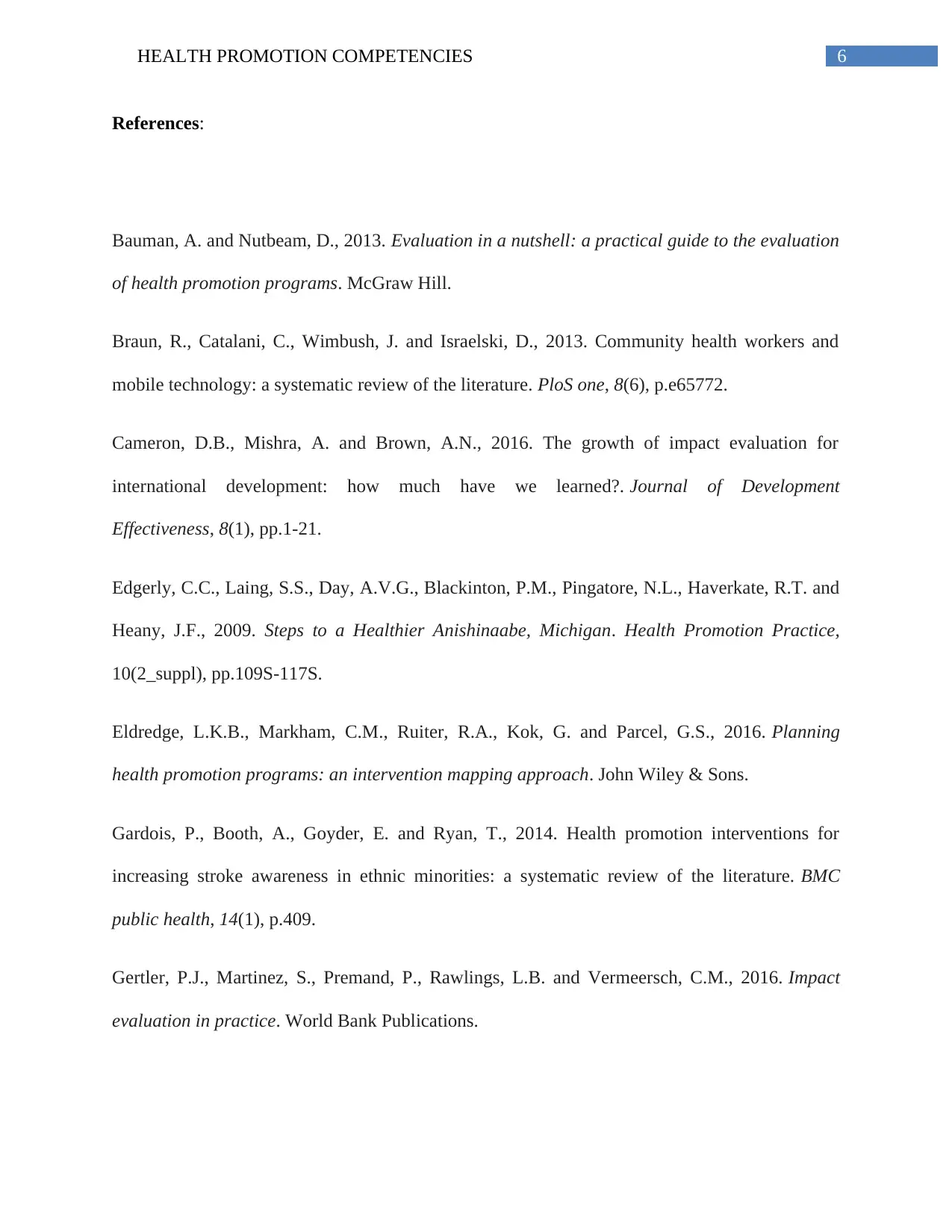
6HEALTH PROMOTION COMPETENCIES
References:
Bauman, A. and Nutbeam, D., 2013. Evaluation in a nutshell: a practical guide to the evaluation
of health promotion programs. McGraw Hill.
Braun, R., Catalani, C., Wimbush, J. and Israelski, D., 2013. Community health workers and
mobile technology: a systematic review of the literature. PloS one, 8(6), p.e65772.
Cameron, D.B., Mishra, A. and Brown, A.N., 2016. The growth of impact evaluation for
international development: how much have we learned?. Journal of Development
Effectiveness, 8(1), pp.1-21.
Edgerly, C.C., Laing, S.S., Day, A.V.G., Blackinton, P.M., Pingatore, N.L., Haverkate, R.T. and
Heany, J.F., 2009. Steps to a Healthier Anishinaabe, Michigan. Health Promotion Practice,
10(2_suppl), pp.109S-117S.
Eldredge, L.K.B., Markham, C.M., Ruiter, R.A., Kok, G. and Parcel, G.S., 2016. Planning
health promotion programs: an intervention mapping approach. John Wiley & Sons.
Gardois, P., Booth, A., Goyder, E. and Ryan, T., 2014. Health promotion interventions for
increasing stroke awareness in ethnic minorities: a systematic review of the literature. BMC
public health, 14(1), p.409.
Gertler, P.J., Martinez, S., Premand, P., Rawlings, L.B. and Vermeersch, C.M., 2016. Impact
evaluation in practice. World Bank Publications.
References:
Bauman, A. and Nutbeam, D., 2013. Evaluation in a nutshell: a practical guide to the evaluation
of health promotion programs. McGraw Hill.
Braun, R., Catalani, C., Wimbush, J. and Israelski, D., 2013. Community health workers and
mobile technology: a systematic review of the literature. PloS one, 8(6), p.e65772.
Cameron, D.B., Mishra, A. and Brown, A.N., 2016. The growth of impact evaluation for
international development: how much have we learned?. Journal of Development
Effectiveness, 8(1), pp.1-21.
Edgerly, C.C., Laing, S.S., Day, A.V.G., Blackinton, P.M., Pingatore, N.L., Haverkate, R.T. and
Heany, J.F., 2009. Steps to a Healthier Anishinaabe, Michigan. Health Promotion Practice,
10(2_suppl), pp.109S-117S.
Eldredge, L.K.B., Markham, C.M., Ruiter, R.A., Kok, G. and Parcel, G.S., 2016. Planning
health promotion programs: an intervention mapping approach. John Wiley & Sons.
Gardois, P., Booth, A., Goyder, E. and Ryan, T., 2014. Health promotion interventions for
increasing stroke awareness in ethnic minorities: a systematic review of the literature. BMC
public health, 14(1), p.409.
Gertler, P.J., Martinez, S., Premand, P., Rawlings, L.B. and Vermeersch, C.M., 2016. Impact
evaluation in practice. World Bank Publications.
Paraphrase This Document
Need a fresh take? Get an instant paraphrase of this document with our AI Paraphraser
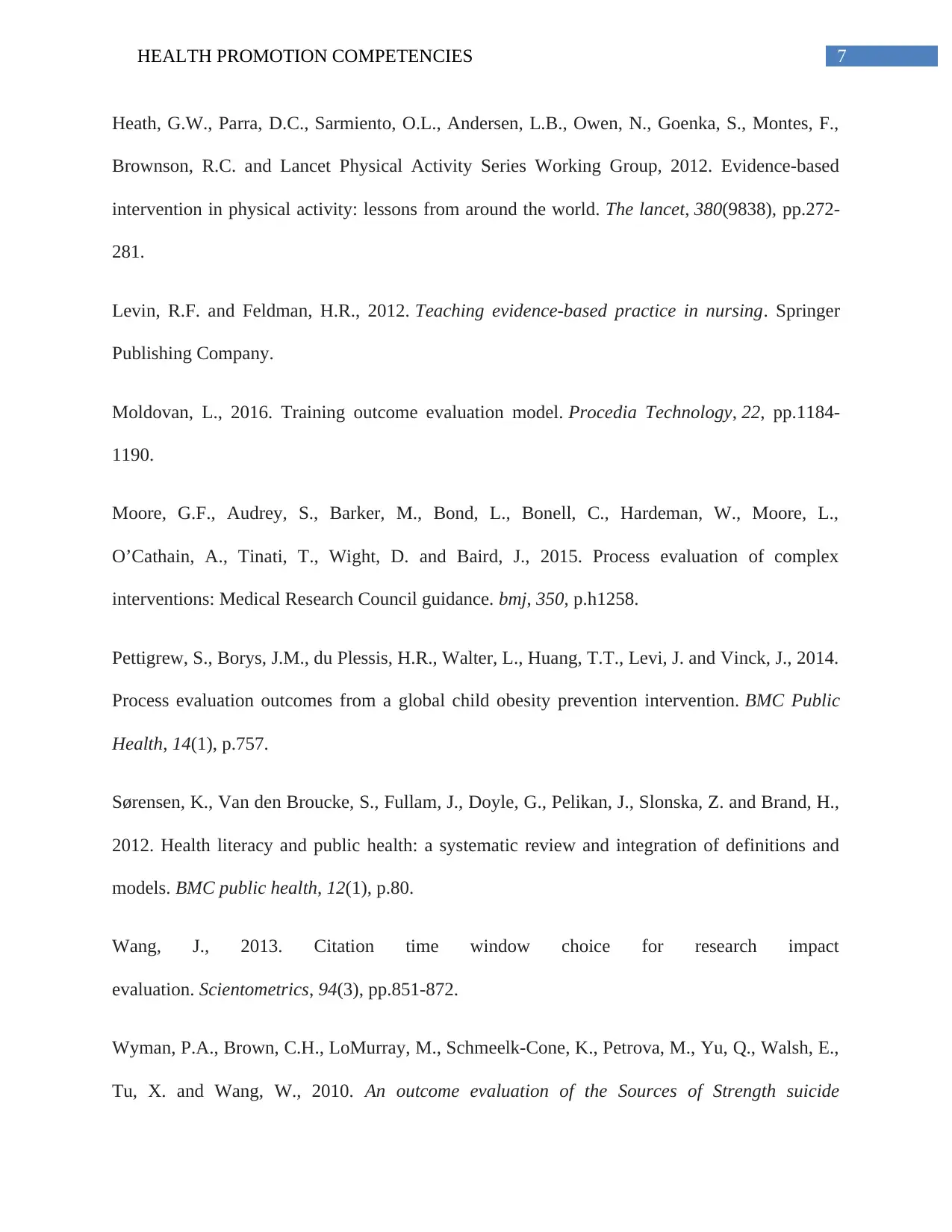
7HEALTH PROMOTION COMPETENCIES
Heath, G.W., Parra, D.C., Sarmiento, O.L., Andersen, L.B., Owen, N., Goenka, S., Montes, F.,
Brownson, R.C. and Lancet Physical Activity Series Working Group, 2012. Evidence-based
intervention in physical activity: lessons from around the world. The lancet, 380(9838), pp.272-
281.
Levin, R.F. and Feldman, H.R., 2012. Teaching evidence-based practice in nursing. Springer
Publishing Company.
Moldovan, L., 2016. Training outcome evaluation model. Procedia Technology, 22, pp.1184-
1190.
Moore, G.F., Audrey, S., Barker, M., Bond, L., Bonell, C., Hardeman, W., Moore, L.,
O’Cathain, A., Tinati, T., Wight, D. and Baird, J., 2015. Process evaluation of complex
interventions: Medical Research Council guidance. bmj, 350, p.h1258.
Pettigrew, S., Borys, J.M., du Plessis, H.R., Walter, L., Huang, T.T., Levi, J. and Vinck, J., 2014.
Process evaluation outcomes from a global child obesity prevention intervention. BMC Public
Health, 14(1), p.757.
Sørensen, K., Van den Broucke, S., Fullam, J., Doyle, G., Pelikan, J., Slonska, Z. and Brand, H.,
2012. Health literacy and public health: a systematic review and integration of definitions and
models. BMC public health, 12(1), p.80.
Wang, J., 2013. Citation time window choice for research impact
evaluation. Scientometrics, 94(3), pp.851-872.
Wyman, P.A., Brown, C.H., LoMurray, M., Schmeelk-Cone, K., Petrova, M., Yu, Q., Walsh, E.,
Tu, X. and Wang, W., 2010. An outcome evaluation of the Sources of Strength suicide
Heath, G.W., Parra, D.C., Sarmiento, O.L., Andersen, L.B., Owen, N., Goenka, S., Montes, F.,
Brownson, R.C. and Lancet Physical Activity Series Working Group, 2012. Evidence-based
intervention in physical activity: lessons from around the world. The lancet, 380(9838), pp.272-
281.
Levin, R.F. and Feldman, H.R., 2012. Teaching evidence-based practice in nursing. Springer
Publishing Company.
Moldovan, L., 2016. Training outcome evaluation model. Procedia Technology, 22, pp.1184-
1190.
Moore, G.F., Audrey, S., Barker, M., Bond, L., Bonell, C., Hardeman, W., Moore, L.,
O’Cathain, A., Tinati, T., Wight, D. and Baird, J., 2015. Process evaluation of complex
interventions: Medical Research Council guidance. bmj, 350, p.h1258.
Pettigrew, S., Borys, J.M., du Plessis, H.R., Walter, L., Huang, T.T., Levi, J. and Vinck, J., 2014.
Process evaluation outcomes from a global child obesity prevention intervention. BMC Public
Health, 14(1), p.757.
Sørensen, K., Van den Broucke, S., Fullam, J., Doyle, G., Pelikan, J., Slonska, Z. and Brand, H.,
2012. Health literacy and public health: a systematic review and integration of definitions and
models. BMC public health, 12(1), p.80.
Wang, J., 2013. Citation time window choice for research impact
evaluation. Scientometrics, 94(3), pp.851-872.
Wyman, P.A., Brown, C.H., LoMurray, M., Schmeelk-Cone, K., Petrova, M., Yu, Q., Walsh, E.,
Tu, X. and Wang, W., 2010. An outcome evaluation of the Sources of Strength suicide

8HEALTH PROMOTION COMPETENCIES
prevention program delivered by adolescent peer leaders in high schools. American journal of
public health, 100(9), pp.1653-1661.
prevention program delivered by adolescent peer leaders in high schools. American journal of
public health, 100(9), pp.1653-1661.
⊘ This is a preview!⊘
Do you want full access?
Subscribe today to unlock all pages.

Trusted by 1+ million students worldwide
1 out of 9
Related Documents
Your All-in-One AI-Powered Toolkit for Academic Success.
+13062052269
info@desklib.com
Available 24*7 on WhatsApp / Email
![[object Object]](/_next/static/media/star-bottom.7253800d.svg)
Unlock your academic potential
Copyright © 2020–2025 A2Z Services. All Rights Reserved. Developed and managed by ZUCOL.



